We may earn revenue from the products available on this page and participate in affiliate programs. Learn more ›
_
Best Overall
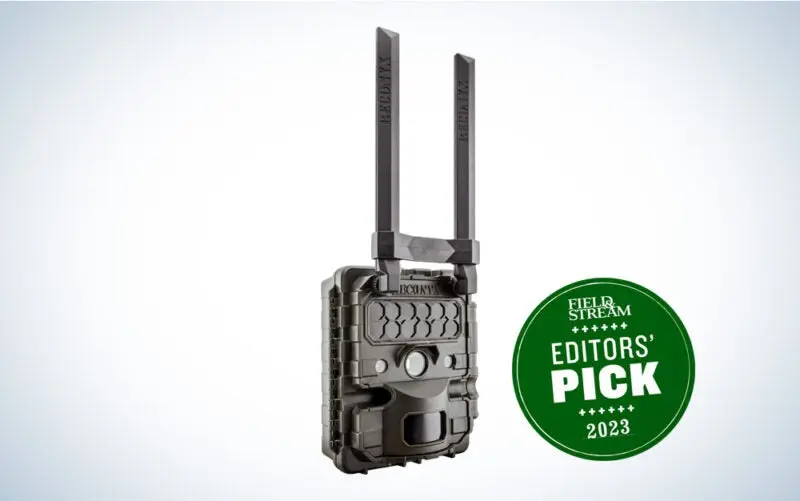
| Reconyx HF2XC Hyperfire 2 Cellular |
LEARN MORE
Summary
The Hyperfire II features an awesome trigger speed, sharp, detailed photos, and does an excellent job transmitting images with an improved signal.
Best Value

| Browning Defender Pro Scout Max Extreme |
LEARN MORE
Summary
The Defender has a simple and straightforward setup and shoots excellent photos and videos transmitted on Verizon or AT&T networks.
Best Detection Range

| Spypoint Flex G-36 |
LEARN MORE
Summary
The Spypoint Flex’s detection range goes out an impressive 150 feet, and the image and video quality are very good.
Last year, I said we’d entered a golden age when it comes to cellular trail cameras. That remains the case in terms of how many great cams are now on the market and the degree to which companies have made wireless cams more user friendly and feature-rich. But based on the average price on new-for-2023 cell cams, any reference to gold seems wrong. This year’s crop offers a whole lot of value—and plenty of performance too.
Like computers, smartphones, and everything else powered by silicon chips, trail cameras just keep on getting better. Pics and videos are sharper and clearer. Apps are packed with more (and more incredible) features. And despite all of that—and the fact that prices on everything seems higher—the cost of the latest cell cams are, for the most part, settling in a neighborhood that most of us can afford. Still, in a tight economy, the decision to drop anywhere from a hundred to several hundred bucks on yet another trail cam, and which one to spend it on, deserves serious consideration. So, we’ve done a bunch of the considering for you.
After weeks of setting up and testing the latest models, we’ve cut through the advertising hype to pick the best cellular trail cameras for 2023.
Best Overall: Reconyx Hyperfire 2 (4G LTE)
Best Value: Browning Defender Pro Scout Max Extreme
Best Detection Range: Spypoint Flex G-36
Best Newcomer: Camojojo Trace
The Rest of the Best Cellular Trail Cameras
How We Tested Cellular Trail Cameras
I installed batteries, an SD card, and SIM card (if required), and then downloaded the correct app to pair each camera with my phone. Once up and running, I set all of them up in my yard and walked, jogged, ran, and ran the dogs past them for days at pre-measured distances, both in daylight and at night. I also deployed cams on mock scrapes to check their performance on wild deer and any other critters that happened by. I gave a special nod to any camera(s) that performed well under these “real world” conditions.
All the while, I evaluated and scored each for ease of setup, picture and video quality, trigger speed, detection range, and any unexpected and useful features. (For more on each of these test categories see “What to Consider When Choosing a Cellular Camera” below.) Here’s how each of the new-for-2023 cell cameras fared.
Best Cellular Trail Cameras: Reviews & Recommendations
Best Overall: Reconyx HF2XC Hyperfire 2 Cellular (4G LTE)
| Best Overall |

Specs
Trigger speed: 0.2 seconds
Detection range: 75 feet
Power: 12 AA batteries
Pros
Fastest trigger on the market
Outstanding picture and video quality
Five-year warranty is the best in the business
Cons
Very expensive
Requires a dozen batteries
Doesn’t send video
Reconyx is the gold standard when it comes to flat-out trail-camera performance. The company’s newest HF2XC Hyperfire 2 model is essentially the same cell cam that won our test last year, but now it’s is 4G LTE enabled, which should result in better signal pickup and improved picture transmission. This camera takes tack-sharp pictures and, thanks to a super-fast trigger, it misses almost nothing. The case is very sturdy and well-built, and the instruction manual is thorough and nicely illustrated.
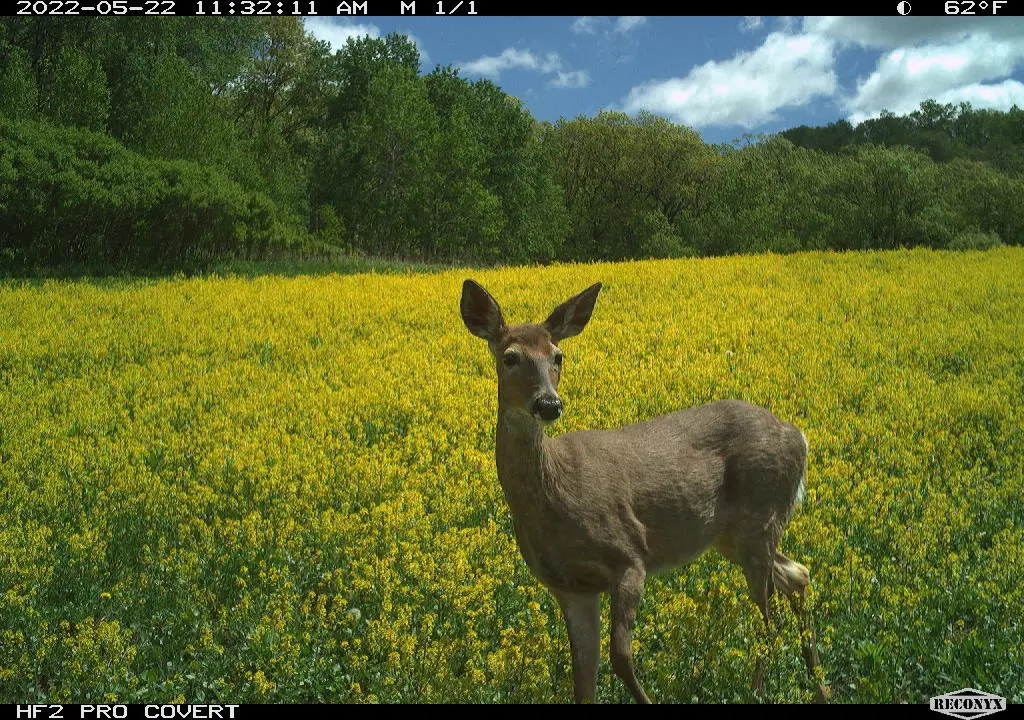
| The picture quality of Reconyx cameras is as good as it gets. Reconyx |
With a retail price of nearly $600, the Hyperfire 2 is, well, wildly expensive. Trust me, I get it. I mean, you could buy anywhere from three to five of any of the other cams on this list for the same price. On the other hand, this is one hell of a good camera. Based on flat-out performance, it earned our Editor’s Pick award again this year. If you have to have best and you don’t care what it cost, the Hyperfire 2 is for you. Also, for a limited time, Reconyx is offering a free solar charger with each purchase of this camera. With the price of batteries 30 to 40 percent higher than last year, going solar makes a whole lot of sense.
Best Value: Browning Defender Pro Scout Max Extreme
| Best Value |

Specs
Trigger speed: 0.25 seconds
Detection range: 120 feet
Power: 8 AA batteries
Pros
Excellent trigger speed
Very good picture quality
Dual carrier technology
Excellent battery life
Cons
Minor setup issue on test camera
I can’t think of anything less surprising than the fact that Browning has come out with another super-solid-performing camera boasting a few extra features that make it even better than the previous year’s cam. It’s kind of their thing. So, as we’ve come to expect from Browning, the trigger speed is zippy on this latest model and picture quality is very good. In a nice touch, the Defender Pro Scout Max Extreme sports Dual Carrier technology, which means it has pre-installed SIM cards for both Verizon and AT&T, and the camera selects and connects to the strongest signal in a given area.
I didn’t have enough time to test battery life for this roundup, but having used Browning trail cams for years, and based on my experience, they will run longer on 8 AA batteries than any other model.

| Screenshots of the Browning app. Browning Trail Cameras |
Setup is typically very straightforward on Browning cams, but I did run into a couple minor technical glitches getting the Max Extreme up in running, but I called customer support and they helped me get things sorted out quickly. The camera does have some really cool new features, including an adjustable trigger speed and SMART IR video, which will keep recording for up to two minutes as long as there’s motion in front of the camera. So, if you’re a cam-geek who gets a thrill from messing around with new gew-gaws, they’re here.
But if (like me) you just want a no-nonsense camera that almost never fails, this is your baby. And with a price that’s only a little higher than the cheapest models in this test, it’s a whole lot of camera for cash—which is why it gets the nod for our 2023 Best Value award. The only problem for Browning is now that they’ve stuffed “Pro,” “Max,” and “Extreme” all into the name of this camera, they may be hard pressed to come up with a moniker for next year’s model.
Best Detection Range: SpyPoint Flex G-36
| Best Detection Range |

Specs
Trigger speed: 0.3 seconds
Detection range: 100 feet
Power: 8 AA batteries
Pros
Pre-installed SIM card automatically selects strongest carrier
Good trigger speed
Outstanding detection zone
Small size
Great value
Cons
Micro SD Card
The coolest thing about the SpyPoint Flex is the pre-installed SIM card, which selects the strongest carrier in the area (including US Cellular, Verizon, and AT&T) and then automatically selects it. The trigger is good on this camera, if not quite as fast as the fastest, and the detection range is outstanding. My neighbor’s tractor triggered my Flex at close to 150 feet. The picture and video quality are solid, too, and I like the small size of this unit, which makes it easy to hang and hide.
The Flex requires a micro-SD card. Now, maybe I’m out a little out of touch here, and maybe everyone will going to micro-SD cards eventually, but I generally dislike these things, as they often require you to get (and keep track of) an adapter. I should say that the Flex is also available in a solar-assisted model, and with the price of batteries, that is certainly worth a look. In the end, there’s very little not to like about the SpyPoint Flex G-36; it’s a solid performer at such a good price that it finished runner-up for Best Value, and by such a small margin that if you choose this model for around $20 less than the Browning, I certainly wouldn’t blame you.
Best Newcomer: Camojojo Trace
| Best Newcomer |
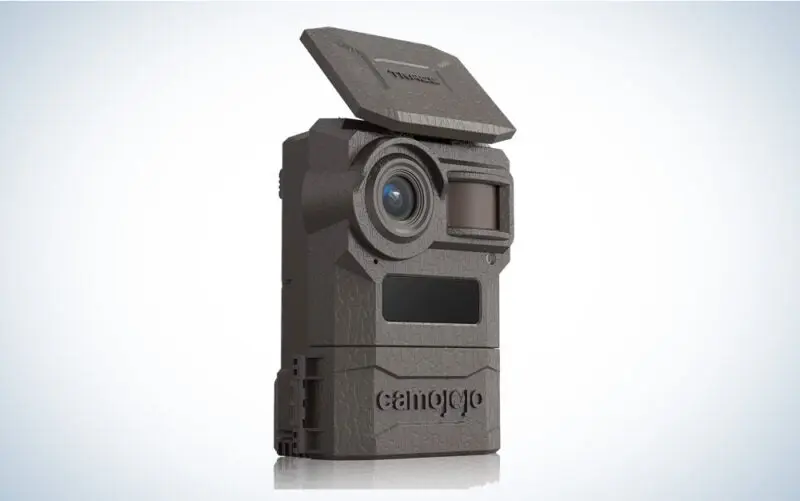
Specs
Trigger speed: 0.25 (advertised)
Detection range: 100 feet
Power: 12 AA batteries
Pros
Easy setup
Impressive detection range
Great value
Cons
Picture and video quality decent, but no great
AT&T only
This newcomer generated a lot of buzz when it first hit the market as $100 cell cam that gets the job done. And the Camojojo does indeed do that. Setup was a breeze, picture quality decent, and I was especially impressed by the detection range. My test camera picked up a doe trotting pat at close to 150 feet, and shot a perfectly acceptable video. I don’t think the Jojo merits its advertised .25 second trigger speed (which would put in the Browning/Reconyx class), but it’s impressively fast nonetheless.
Still, when you put the Camojojo head-to-head with the competition, you can see why it costs less. For one, the camera only comes with an AT&T SIM card, so users with Verizon (and other) carriers might be frustrated until they get this worked out. And while the pics and vids are perfectly fine for an entry-level camera, they are not quite as good as some cam costing only $20 or $30 more. Still, if you’re on a tight budget, have AT&T, and all you need is pics and vids good enough to show you generally what’s out there, the new Camojojo will do it. If you shop around, you can find this cam for around $100, and plans are very reasonable.
Covert WC20V
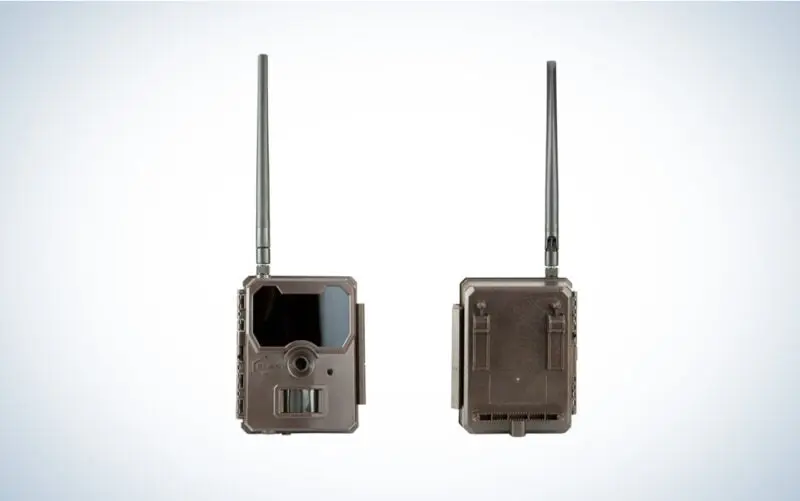
Specs
Trigger speed: 0.3 seconds
Detection range: 80 feet
Power: 12 AA batteries
Pros
Good trigger speed
Better than advertised detection range
Super-easy setup
Good value
Cons
Requires a dozen batteries
This camera made me smile during the setup process, which is saying something. With clear, concise directions that any could follow, the WC20 gets my nod for the easiest camera of the bunch to get up, running, and sending you pics right away. And as if to prove the point, it captured a pair of nice bucks the first night I put it out.
My test model overachieved on it advertised detection range of 80 feet, picking up on deer and my neighbor’s ATV at well over 100 feet. Picture quality is solid and the trigger speed is right in line with most others at this price. I know that I’m beginning to sound like a broken record, but it’s a good thing for all of us that this is yet another example of a solid-performing camera at a very reasonable price. And this one is especially user-friendly to boot.
Muddy Matrix
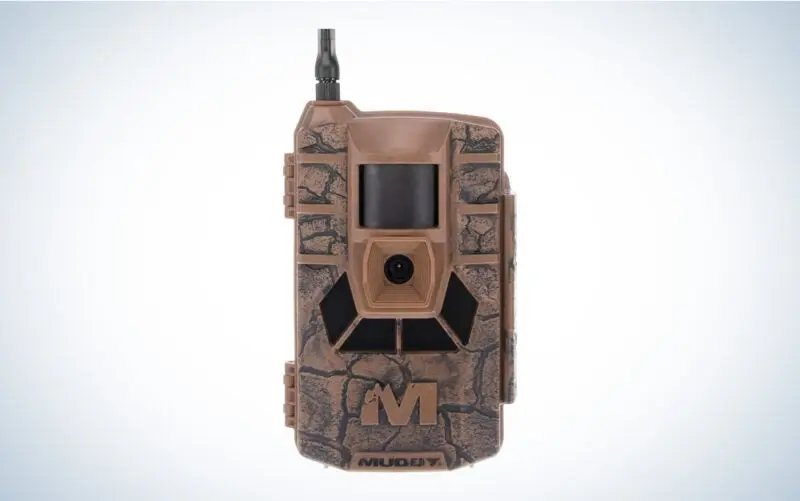
Specs
Trigger speed: .40 seconds
Detection range: 80 feet
Power: 8 AA batteries
Pros
Very good picture and video quality
Great App
Affordable Plans
Good Value
Cons
Comparatively slow trigger speed
Comparatively small detection range
Test-camera connectivity issues
The Muddy Matrix has plenty of checkmarks on the plus side of the ledger, but also a couple minuses to consider. Picture and video is very good. Also, the Muddy app (which is basically the same as Stealth Cam’s, if you’re familiar with that one) has some very nice features; you can “train” the camera to select for species, times of day, even individual animals. Also, the camera has dual AT&T and Verizon SIM cards, and automatically selects the strongest signal in the area.
I have to report, however, that I had a heckuva time getting my test camera to achieve a solid signal connection. On the one hand, I live in an area where this can be a problem, and it may not have been the camera’s fault. On the other, no other camera struggled so mightily. Also, trigger speed is comparatively slow.
That said, I do very much appreciate what Muddy is doing to make the cell-cam game more affordable to get into. One factor that makes folks hesitate to get into the wireless game is cost, leading to the legitimate question: Is is worth it? Muddy is doing it best to make that answer “yes” by offering deals for multiple cameras purchased at the same time, and some very affordable data plans. If you’re ready to dive into the wireless pool and need multiple units, this is a solid option and value.
Editor’s Note: Bushnell, Moultrie, Spartan, and Stealth Cam were unable able to send a new-for-2023 models in time for out initial testing, but some of these cams are now en rout, and we will add them to this roundup and soon as testing is complete. In the meantime, their 2022 models are still available and in some cases still their newest current offering. Here’s what we had to say about them after last year’s test:
Bushnell CelluCore 30 No-Glow
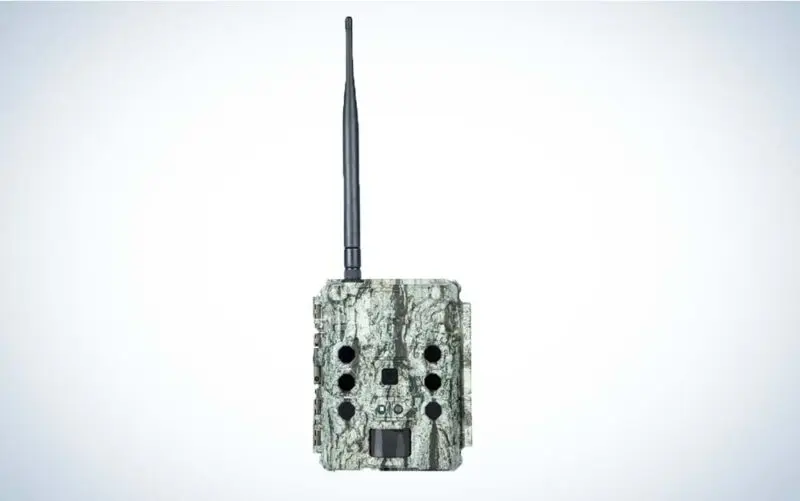
Specs
Trigger speed: 0.2 seconds
Detection range: 80 feet
Power: 12 AA batteries
Pros
Good trigger speed
Solid daytime pics
Internal screen viewer to aid setup
Among the most simple setups in the test
Cons
Fairly spendy in comparison
Night pics suffer a bit at longer ranges
Bushnell cameras have shown nothing but increased improvement in the last few years, and the CelluCore exemplifies that trend. The nice pics and easy setup are a huge plus for Bushnell. The impressive 0.2-second trigger speed helps capture sharp images and can keep up with fast-moving deer. Plus, the fast image recovery time recovery and subtle infrared flash elevate this cam to the next level. The only thing keeping this camera from the top models is a moderate detection range, and the data plans are, well, not much.
Moultrie Mobile Edge

Specs
Trigger speed: .85 seconds
Detection range: 80 feet
Power: 12AA batteries
Pros
Amazing price
Excellent app
Easy and seamless setup
Cons
Lethargic trigger
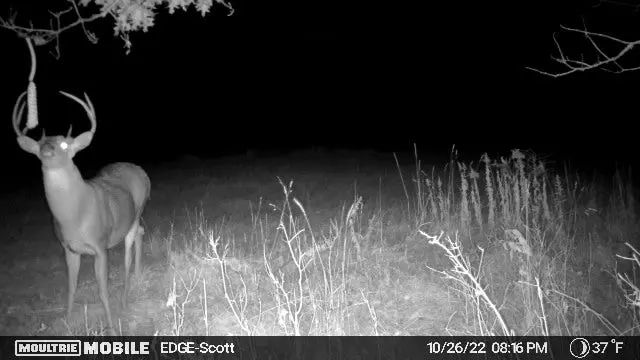
| The Moultrie Edge snaps a nighttime pic of a mature buck at the author’s mock scrape. Scott Bestul |
Moultrie’s app is one of the coolest out there with features like image recognition (so you can quickly sort bucks from does, for example) and activity recording (which allows you to identify top movement times and other useful info) as well as unlimited cloud storage. And at less than a C-note, it’s tough to argue against this being one of the best-value cellular cams out there. Of course, important features like trigger speed suffer significantly, but in the right setups (mock scrapes or bait piles) the Edge should perform just fine. We also took a closer look at the new Moultrie Edge after the test.
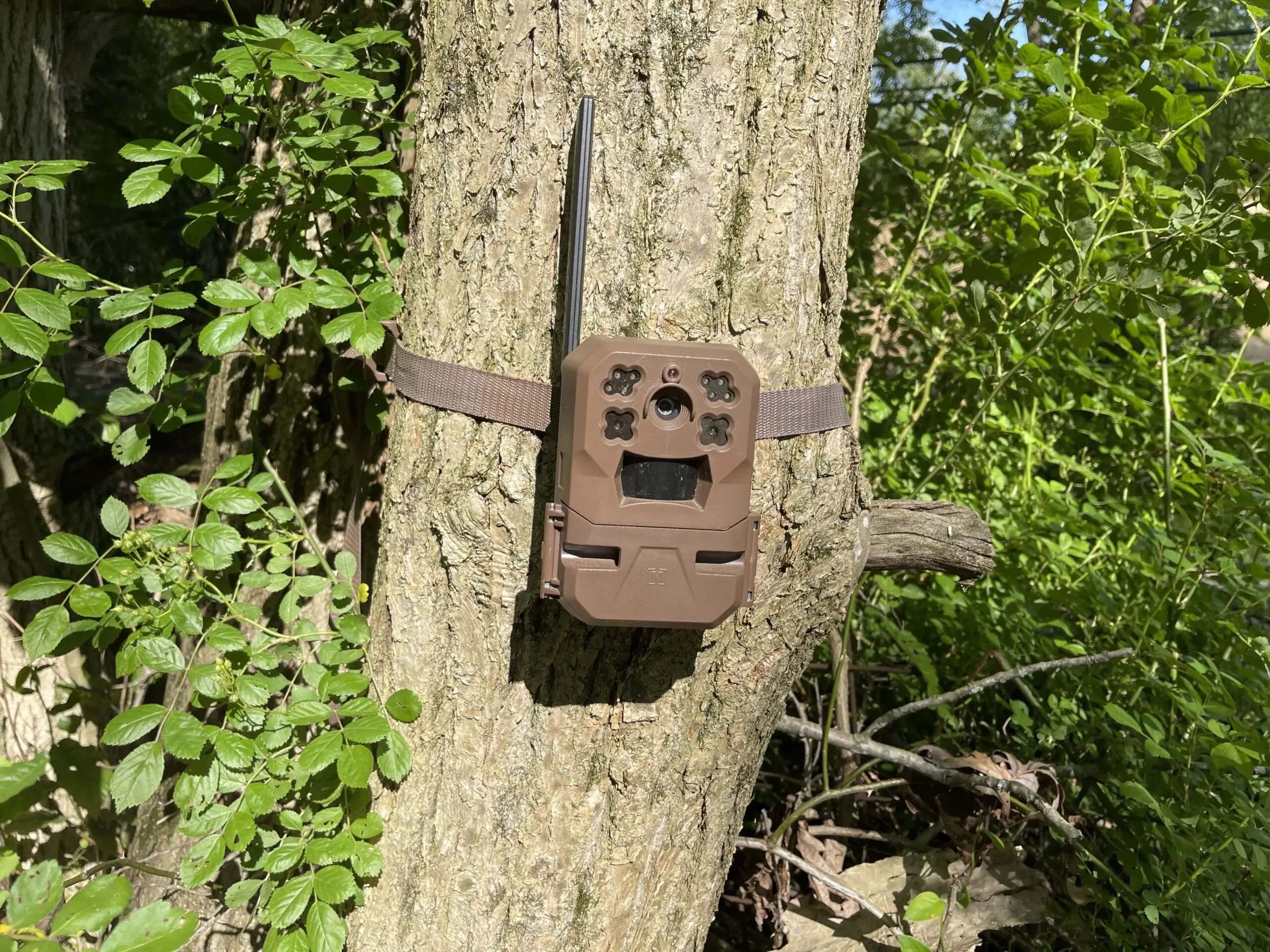
| F&S’s Executive Editor, Amanda Oliver, has a Moultrie Mobile Edge trail cam on her property in northern Maryland. |
Spartan GoCam Ghost
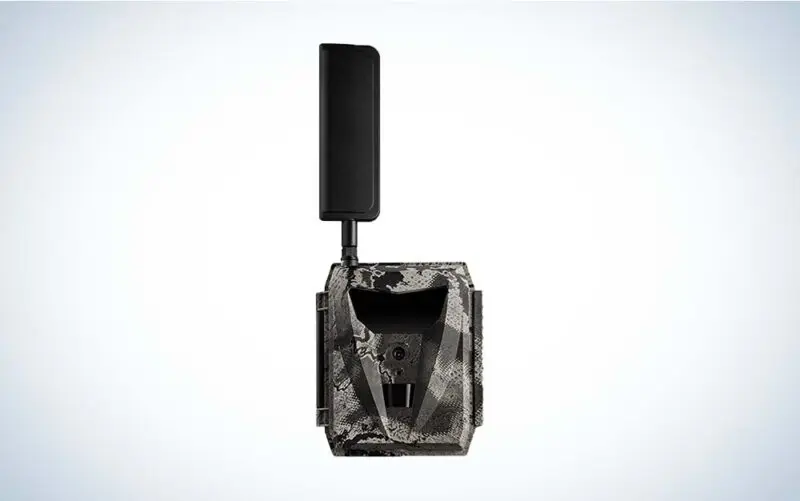
Specs
Trigger Speed: .4 seconds
Detection range: 60 feet
Power: 12AA batteries
Pros
First camera to offer live-streaming video
Great image/video quality
Rugged and durable housing and easy setup
Cons
Pretty average detection range and trigger speed
High price point
This is probably the best housing design in the test. In addition to being a cool-looking cam, the Spartan GoCam Ghost is rugged. It seems like it could get run over by a truck and keep snapping pics and shooting videos. The live-streaming option is decidedly cool for people who need MRI (most recent information) right now….though it may also raise eyebrows for those who question the ethics of trail cams in the first place. (I’m generally not one of them.)
Stealth Cam DS4K Transmit
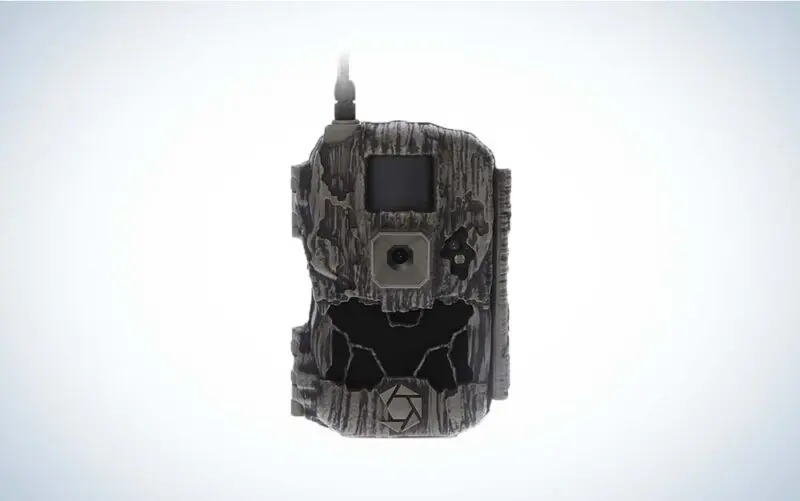
Specs
Trigger speed: .3 seconds
Detection range: 100 feet
Power: 12AA batteries
Pros
Quick trigger
Good detection range
Great housing
Simple setup and many programming options
Cons
Mediocre night pics
Higher price point
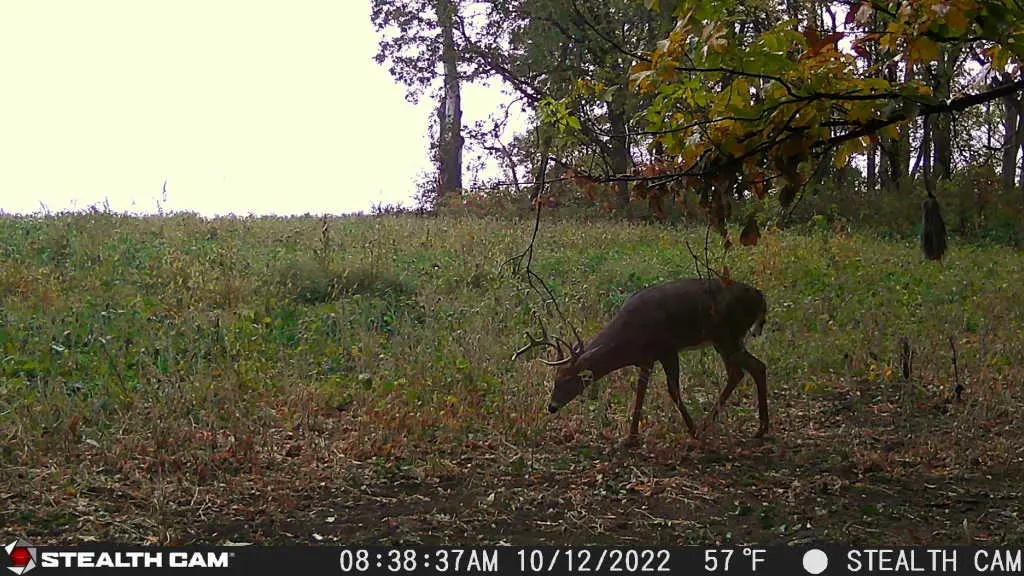
| A mature whitetail buck captured on the Stealth Cam DS4K. Scott Bestul |
I love the speedy trigger on this Stealthcam trail cam and the programming options are pretty incredible; four different video resolutions and camera MP options, as well as a burst mode that’s as good as any models (it’ll shoot up to 9 images per triggering event). I also found the camera easy to set up. While the night pics were less than stellar, that’s a small beef. Look for deals on this camera, and you won’t be disappointed.
What to Consider When Choosing a Cellular Trail Camera
Ease of Setup
Most cellular trail camera manufacturers have accepted the fact that not all their customers are 25 and were born with a smartphone in their hand, but some have not. Cellular cams
should come with clear instructions and be easy to program and get running. All the cams I tested were run from an app where you set camera commands and settings, and where pics are sent. This is different than the original wireless cams, which typically sent images to the user via text (one of my buddies still refers to wireless cams as “texting cams” for this reason). How easily these apps set up, run, and monitor the camera is important.
Picture Quality
This can be tied into cost (as in, the more you spend, the better the pics), but not always. Trust me on this: After a while, the novelty of getting pics sent to your phone will wear off, and you’ll get irritated by blurred and grainy images. Some people are willing to give cell cams a pass on picture quality because they provide other benefits. I’m not one of them.
Trigger Speed
This is how long it takes the camera to snap a pic (or start shooting video) from when it detects movement. Generally speaking, the faster the better. One-fourth/second (0.25) is about as good as it gets, and a half-second is respectable for most camera setups. Anything much slower than that is decidedly ho-hum, and the camera better be darn good at something else.
Detection Range
This is the maximum distance at which a camera will “sense” a triggering object (hopefully a critter, but weeds and tree branches will also trigger it; something to keep in mind when setting cameras up). Again, as a rule, the greater the distance the better; the camera will get more pics of more animals.
Megapixels
I intentionally left this category out of my final evaluations, as it’s one of the most misunderstood features of trail cams. Manufacturers can exaggerate MP ratings through a process known as interpolation, which digitally adds megapixels to a photo without actually improving the picture. In other words, a 30 MP camera may not have any clearer or better pics than a 3 MP camera. The best way to judge the quality of a camera’s pics is to simply look at the pics.
App Quality and Bonus Features
A basic cell-cam app should make it easy for you to get the camera set up, change settings, and receive photos, but apps that make it especially easy to organize photos or identify trends to nail down daily patterns among the critters your monitoring can be a big plus. By the same token, little hardware extras, like mounts or brackets that help you aim the camera, are an important consideration, too.
Best Cellular Trail Cameras: Final Thoughts
Best Overall: Reconyx Hyperfire 2 (4G LTE)
Best Value: Browning Defender Pro Scout Max Extreme
Best Detection Range: Spypoint Flex G-36
Best Newcomer: Camojojo Trace
The Rest of the Best Cellular Trail Cameras
What impressed me most about this year’s crop of cell cams is how many really solid performers are now available for less than $150, including a couple threatening the C-note mark. Almost as important, these cams are getting even more user-friendly. While I sense that we’re a year or two away from the pinnacle of cell-cam performance, I also feel that waiting for things to get perfect is a big mistake. Today’s wireless cameras simply send more and better pics and videos than they ever have, and ignoring those capabilities will prevent you from enjoying some of the most scouting fun you might have all season. Shop wisely and the camera that perfectly fits your needs can be found in this year’s lineup.
Why Trust Us
For more than 125 years, Field & Stream has been providing readers with honest and authentic coverage of outdoor gear. Our writers and editors eat, sleep, and breathe the outdoors, and that passion comes through in our product reviews. You can count on F&S to keep you up to date on the best new gear. And when we write about a product—whether it’s a bass lure or a backpack—we cover the good and the bad, so you know exactly what to expect before you decide to make a purchase.
![Field & Stream [dev]](https://images.ctfassets.net/fbkgl98xrr9f/1GnddAVcyeew2hQvUmrFpw/e4ca91baa53a1ecd66f76b1ef472932b/mob-logo.svg)





